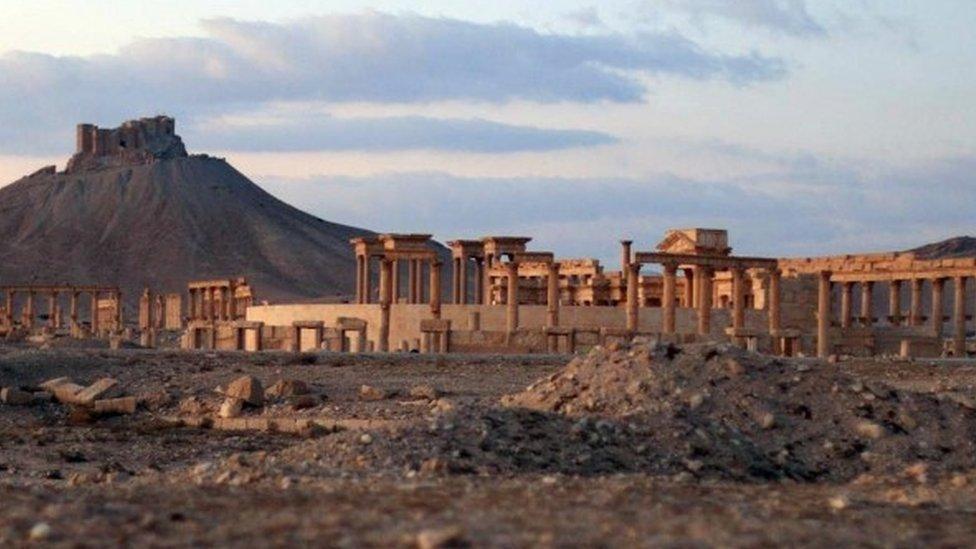Syrian conflict: Assad's fragmenting military
- Published

So-called Islamic State has returned to Palmyra - the group claims to have taken this image on 11 December
The pendulum swing of military advantage in Syria is well-illustrated by the contrasting fortunes of the Syrian government forces in Aleppo and Palmyra.
In Aleppo the pro-regime offensive is continuing to squeeze rebel fighters into a smaller and smaller sector of the eastern part of the city.
Most commentators believe it is only a matter of time before the rebels lose their foot-hold entirely; either due to a final government offensive or through some kind of negotiated withdrawal to try to bring a respite to the remaining civilians there.
But in Palmyra, far to the south-east of Aleppo, it is so-called Islamic State that is on the offensive.
Over the weekend a force of some 4,000 fighters retook the city centre despite significant efforts by Russian air power to forestall their advance.

Government forces have been retaking eastern Aleppo district by district
This represents something of an embarrassment for Moscow - Palmyra's recapture earlier this year was heralded as a major victory and proof positive that Russia's intervention could turn the tide of battle for President Assad's forces.
Palmyra's recapture was followed by a carefully staged propaganda event. The Russians flew in a symphony orchestra and put on a major show, presenting their victory as a triumph of the forces of culture over those of barbarism.

Read more:

Well the barbarians are back in Palmyra, Syrian government forces retreating west of the town where the battle continues.
So far Russian air power has not been able to turn the tide. It may only be a temporary setback for the Assad regime, but some Russian military commentators are noting that the concentration of IS fighters ahead of the offensive should have been spotted and dealt with.
The recapture of Palmyra highlights the residual weakness of Syrian government forces, to an extent obscured by the recent focus on Aleppo.
In reality the Syrian army is a shadow of the force that began this conflict some six years ago. Long years of bitter campaigning have taken a toll on personnel and equipment. But other factors are also in play.
A significant part of the Syrian military has simply fallen away to be integrated into a variety of localised militia forces, not so very different in structure from the rebels they are fighting. This is an aspect of the Syrian war that has not been given significant attention until recently.

Some parts of the Syrian military have broken off to fight as pro-government militia
Once again it is the open source intelligence analysts of Bellingcat, external who have scoured the internet to pull together a fascinating snapshot of this militia phenomenon.
The forces fighting on the side of the Assad regime are an extraordinary patchwork of units - some from the regular armed forces but equally as many from a variety of militias.
Some of these, Bellingcat says, may be no more than a few dozen men strong linked to a village or neighbourhood.
Russian links
Other groups field a few thousand men, numerous pieces of armour and artillery and have a national presence, with their own training camps and networks. The Bellingcat study also notes that the ties of these groups to Damascus "and more importantly, the level of control Damascus exerts over them varies".
Bellingcat's Russian counterpart, the Conflict Intelligence Team, external, has also studied the links between the Russian military and some of these militias.
Again open source intelligence analysts have turned up pictures on Facebook sites - group photos with fighters posing with Russian officers and even Russians presenting gallantry medals to individual fighters.

A Russian soldier inspects damage in government-held western Aleppo - the Russian military plays a huge role in Syria
Western analysts have been impressed by the proficiency of the Russian special forces' ability to work with such groups.
Of course there is a huge foreign contingent fighting on behalf of the Assad regime as well. In addition to Russia's role (it has supplied air power, artillery and special forces on the ground) Iran has also played a prominent part.
Lyse Doucet reports from Tariq al-Bab as families who have fled the fighting in Aleppo gather together
Iranian advisers have helped to co-ordinate a sizeable Iranian-proxy force of Shia militias recruited from Pakistan, the Gulf and elsewhere. The Iranian-backed Lebanese militia Hezbollah has also played a significant role in the fighting.
Military analysts believe that without Russia's intervention from the air and the huge additional manpower provided by these militias, the Assad regime would have been swept away.
So despite the regime's successes in Aleppo, it is the very weakness of the government forces that is the crucial factor here. As Palmyra shows, the government risks spreading its limited resources too thinly - it cannot hold all the places it has recaptured, and President Assad's claims that he will retake all the territory lost to his opponents is just empty bravado.
It is Syrian government weakness that will determine the next stage of the conflict once Aleppo falls.